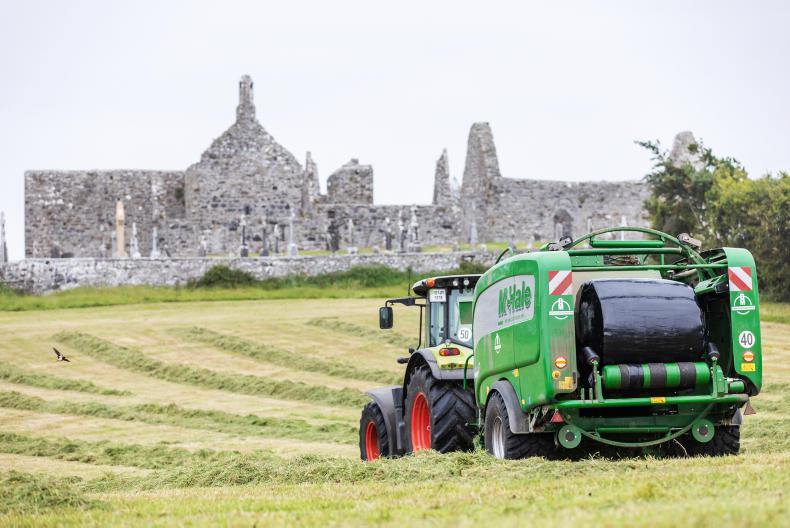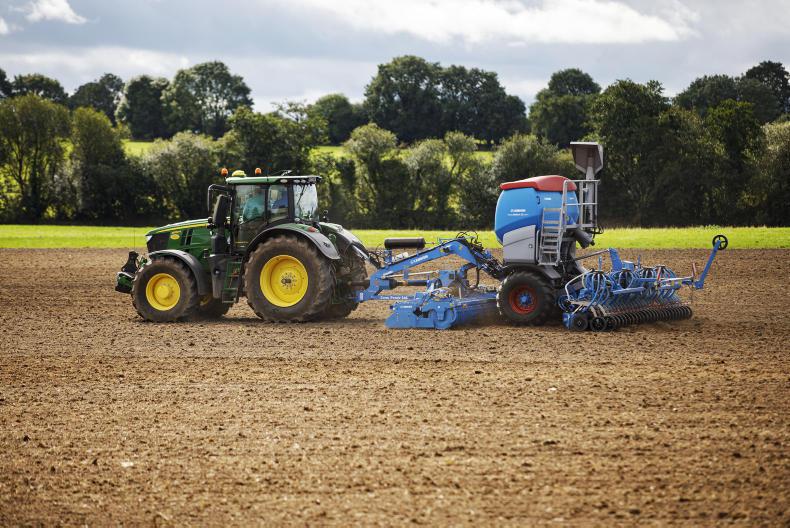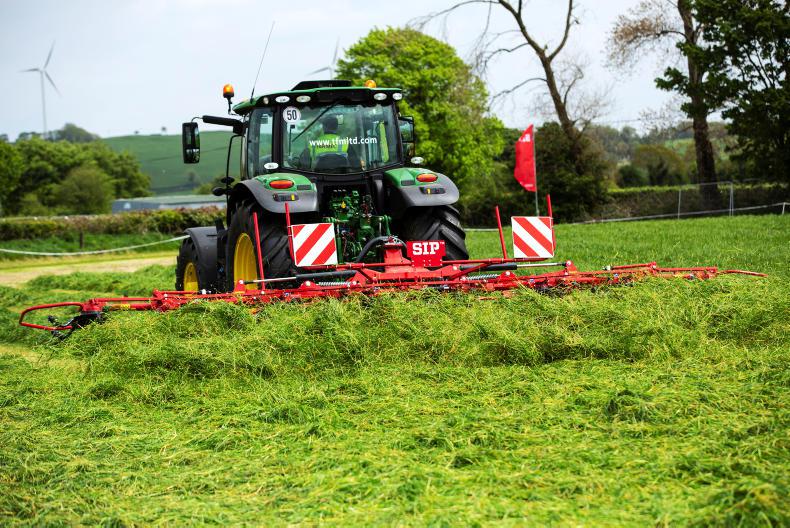Over the past decade, we have seen significant advancements in both the working width and the technology involved in all types of machinery. Any contractor or farmer will tell you, the key driver of these changes has been the ever-shortening weather windows and the increasing shortage of skilled labour.
Tighter margins have increased the requirement on livestock farmers to maximise the quality of their silage, driving contractors to pursue machines with increased output capacity.
Meanwhile, equally tight margins coupled with increased emphasis on reducing inputs and cutting waste has driven the demand for technology on tillage equipment.
As machinery has increased in size and output, it has become more environmentally friendly than previously, particularly from an emissions perspective.
Over the past decade, we have seen huge advancements in forage equipment. The ever-challenging narrow weather windows and lack of skilled labour, in combination with the increased requirement for quality silage, has been the key driver for machines with higher output capacity. Although machinery continues to grow in size and working width, the real advancements have been seen in machine efficiency and output, helped by technological advances.

Some of the big trends we have seen over the past 10 years include the exponential growth of rakes and tedders and the move towards mounted mowers. \ Donal O’Leary
From an initial glance, the big trends we have seen include the exponential growth of rakes and tedders and the move towards mounted mowers, with most contractors running double- and triple-mower combination setups on large tractors.
The shift has been to higher horsepower foragers which offer increased throughput capability. This, in turn, has demanded heavier wheel loaders with more hydraulic and horsepower capacity to shift this increased flow of grass to the silage pit.
Over the past 10 years, all machine types have increased remarkably in horsepower, especially self-propelled forage harvesters. This specific market has grown in numbers and also in the physical size and output capacity of machines.
The average horsepower of these machines has risen from 400hp to 600hp and this continues to increase. Ten years ago, a 1,000hp forage harvester would have been unheard of in Irish machinery circles.
Major brands
Today, all the major brands in the market offer machines in this power bracket, with several working across the island of Ireland.
There were record sales of new forage harvesters in 2019, with 58 new units registered – up almost 66% on the previous year. As well as harvesting crops, these machines now also harvest data. With top-quality silage as an end goal alongside data production, manufacturers have introduced near-infrared (NIR) sensing systems to analyse the constituents of forage as it passes through the spout of the machine.
Like forage equipment, tillage machinery has grown in size, but to a lesser extent, over the past decade. Drills of up to 5m and 6m have come closer to the norm for many of the larger farmers and contractors. In saying that, many smaller operators have stuck with the trusty 3m, but many of these operators have progressed their operations through technological advancements with the help of GPS.
The TAMS II scheme for tillage farmers, known as the Tillage Capital Investment Scheme, has helped to bring such advancements closer to the reach of the Irish farmers.
The widespread use of GPS systems has probably been the biggest step forward in the past decade for tillage farmers.

The widespread use of GPS systems has probably been the biggest step forward in the past decade for tillage farmers.
TAMS II funding and the widespread uptake of GPS systems has led farmers to increase the spec of new drills, fertiliser spreaders and sprayers, etc, to include rate and section control systems, with automatic shut-off. This, in turn, has made farms more efficient and contributed to a more environmentally sustainable farming model.
As with drilling technology, sprayers have also increased in size and output, with many larger farms now operating machines with boom widths of up to 36m. But it’s not just a story about boom width. Nozzle technology has progressed considerably also and this, along with the use of section control, has led to more precise spray application regardless of conditions.
With increasing pressure evident on chemical weed control in recent years, a number of manufacturers of sprayers and cultivation equipment have strategically invested in mechanical weeding technology.
Mechanical options are shaping up to be a reliable alternative for the future –over the next 10 years, we expect to see a gradual transition to such technology. Some manufacturers are developing camera-sensing technology for integration with these implements, to ensure absolute precision so that crop plants do not suffer damage.
Meanwhile, we see other manufacturers working on concepts which spot-spray weeds.
Using hyperspectral sensors which scan the crop ahead of the sprayer, artificial intelligence is used to analyse the images and recognise the species that need treating. Only the required nozzle is then opened to spray that specific target plant.
Manufacturers are claiming that this technology opens the possibility of managing herbicide resistance by using more targeted active substance. One such manufacturer has said that initial figures in reducing the use of chemicals are promising, and that they have reduced weed numbers forage by up to 80% in their trials.
Regarding combines, we have seen a slight trend towards larger horsepower with wider headers over the past decade. However, more notably, we have seen straw walker machines out-sell rotaries.
In 2010, the ratio was approximately 55% walker to 45% rotary machines, with a typical combine being around 360hp fitted with a 20ft header. In today’s market, this trend has moved towards approximately 75% walker to 25% rotary, with a typical new machine being 400hp and fitted with a 22ft header.
Looking back over the past decade, FTMTA figures show that sales of new tractors have averaged 1,807 units per year. If we look at the power bands, the trend is towards larger horsepower machines. Roll the clock back to 2012 when power bands were first recorded in Ireland – 27% of new tractors sold were under 100hp. In the first seven months of 2020, just 9% of the new tractors sold were under 100hp.
In 2012, 60% of new tractors sold were under 120hp. So far in 2020, we see 40% of new tractors sold coming in under 120hp. In both years, the majority of sales were in the 101hp to 120hp range. However, as Figure 1 shows, the move towards larger tractors is evident. In fact, over half of all tractors sold this year to date were over 120hp.
What do the next 10 years hold?
It is difficult to say what the next 10 years will bring for Irish agriculture, as EU policies will continue to shape its future. From a machinery perspective, the physical size of equipment being sold in Ireland is likely to soon reach its limit, if it has not already done so.
With this, we feel that the next 10 years will bring greater advancements in machine efficiency. However, we envisage the major advancements in the next decade to come from technology.
If we look back to the last Agritechnica exhibition in Germany, the world stage for farm machinery, all major manufacturers were showcasing their telematic systems. This “connected systems” approach is where machines communicate with each other, the owners, the dealer and other connected farm systems.
These telematic systems allow the machine owner and the dealer to keep a close eye on machine performance and productivity.
Theoretically, we will begin to see more and more remote fault finding, even before the dealer visits the farmyard. Similarly, dealers will soon be contacting the operator, telling them that a component is about to fail or that the machine is due a service, etc.
From an agronomy point of view, telematics will monitor farm operations from planting right through to harvest. Tractors will talk to planters, with IsoBus and GPS systems playing a major role. Again, theoretically, this will allow evidence-based decisions to be made on the associated data.
A farmer using yield mapping on his/her combine can make changes when cultivating, sowing or spreading fertiliser when it comes to replanting, helping to save inputs and get the most from the land.

Some of the big trends we have seen over the past 10 years include the exponential growth of rakes and tedders and the move towards mounted mowers. \ Donal O'Leary
The past decade has seen machine size and operating capacity continue to increase.Technology has helped to add to the field efficiency of most of these bigger machines. It seems likely that machinery size is nearing its limit for Ireland and that future efficiencies may come more from the use of technology and telematics.
Over the past decade, we have seen significant advancements in both the working width and the technology involved in all types of machinery. Any contractor or farmer will tell you, the key driver of these changes has been the ever-shortening weather windows and the increasing shortage of skilled labour.
Tighter margins have increased the requirement on livestock farmers to maximise the quality of their silage, driving contractors to pursue machines with increased output capacity.
Meanwhile, equally tight margins coupled with increased emphasis on reducing inputs and cutting waste has driven the demand for technology on tillage equipment.
As machinery has increased in size and output, it has become more environmentally friendly than previously, particularly from an emissions perspective.
Over the past decade, we have seen huge advancements in forage equipment. The ever-challenging narrow weather windows and lack of skilled labour, in combination with the increased requirement for quality silage, has been the key driver for machines with higher output capacity. Although machinery continues to grow in size and working width, the real advancements have been seen in machine efficiency and output, helped by technological advances.

Some of the big trends we have seen over the past 10 years include the exponential growth of rakes and tedders and the move towards mounted mowers. \ Donal O’Leary
From an initial glance, the big trends we have seen include the exponential growth of rakes and tedders and the move towards mounted mowers, with most contractors running double- and triple-mower combination setups on large tractors.
The shift has been to higher horsepower foragers which offer increased throughput capability. This, in turn, has demanded heavier wheel loaders with more hydraulic and horsepower capacity to shift this increased flow of grass to the silage pit.
Over the past 10 years, all machine types have increased remarkably in horsepower, especially self-propelled forage harvesters. This specific market has grown in numbers and also in the physical size and output capacity of machines.
The average horsepower of these machines has risen from 400hp to 600hp and this continues to increase. Ten years ago, a 1,000hp forage harvester would have been unheard of in Irish machinery circles.
Major brands
Today, all the major brands in the market offer machines in this power bracket, with several working across the island of Ireland.
There were record sales of new forage harvesters in 2019, with 58 new units registered – up almost 66% on the previous year. As well as harvesting crops, these machines now also harvest data. With top-quality silage as an end goal alongside data production, manufacturers have introduced near-infrared (NIR) sensing systems to analyse the constituents of forage as it passes through the spout of the machine.
Like forage equipment, tillage machinery has grown in size, but to a lesser extent, over the past decade. Drills of up to 5m and 6m have come closer to the norm for many of the larger farmers and contractors. In saying that, many smaller operators have stuck with the trusty 3m, but many of these operators have progressed their operations through technological advancements with the help of GPS.
The TAMS II scheme for tillage farmers, known as the Tillage Capital Investment Scheme, has helped to bring such advancements closer to the reach of the Irish farmers.
The widespread use of GPS systems has probably been the biggest step forward in the past decade for tillage farmers.

The widespread use of GPS systems has probably been the biggest step forward in the past decade for tillage farmers.
TAMS II funding and the widespread uptake of GPS systems has led farmers to increase the spec of new drills, fertiliser spreaders and sprayers, etc, to include rate and section control systems, with automatic shut-off. This, in turn, has made farms more efficient and contributed to a more environmentally sustainable farming model.
As with drilling technology, sprayers have also increased in size and output, with many larger farms now operating machines with boom widths of up to 36m. But it’s not just a story about boom width. Nozzle technology has progressed considerably also and this, along with the use of section control, has led to more precise spray application regardless of conditions.
With increasing pressure evident on chemical weed control in recent years, a number of manufacturers of sprayers and cultivation equipment have strategically invested in mechanical weeding technology.
Mechanical options are shaping up to be a reliable alternative for the future –over the next 10 years, we expect to see a gradual transition to such technology. Some manufacturers are developing camera-sensing technology for integration with these implements, to ensure absolute precision so that crop plants do not suffer damage.
Meanwhile, we see other manufacturers working on concepts which spot-spray weeds.
Using hyperspectral sensors which scan the crop ahead of the sprayer, artificial intelligence is used to analyse the images and recognise the species that need treating. Only the required nozzle is then opened to spray that specific target plant.
Manufacturers are claiming that this technology opens the possibility of managing herbicide resistance by using more targeted active substance. One such manufacturer has said that initial figures in reducing the use of chemicals are promising, and that they have reduced weed numbers forage by up to 80% in their trials.
Regarding combines, we have seen a slight trend towards larger horsepower with wider headers over the past decade. However, more notably, we have seen straw walker machines out-sell rotaries.
In 2010, the ratio was approximately 55% walker to 45% rotary machines, with a typical combine being around 360hp fitted with a 20ft header. In today’s market, this trend has moved towards approximately 75% walker to 25% rotary, with a typical new machine being 400hp and fitted with a 22ft header.
Looking back over the past decade, FTMTA figures show that sales of new tractors have averaged 1,807 units per year. If we look at the power bands, the trend is towards larger horsepower machines. Roll the clock back to 2012 when power bands were first recorded in Ireland – 27% of new tractors sold were under 100hp. In the first seven months of 2020, just 9% of the new tractors sold were under 100hp.
In 2012, 60% of new tractors sold were under 120hp. So far in 2020, we see 40% of new tractors sold coming in under 120hp. In both years, the majority of sales were in the 101hp to 120hp range. However, as Figure 1 shows, the move towards larger tractors is evident. In fact, over half of all tractors sold this year to date were over 120hp.
What do the next 10 years hold?
It is difficult to say what the next 10 years will bring for Irish agriculture, as EU policies will continue to shape its future. From a machinery perspective, the physical size of equipment being sold in Ireland is likely to soon reach its limit, if it has not already done so.
With this, we feel that the next 10 years will bring greater advancements in machine efficiency. However, we envisage the major advancements in the next decade to come from technology.
If we look back to the last Agritechnica exhibition in Germany, the world stage for farm machinery, all major manufacturers were showcasing their telematic systems. This “connected systems” approach is where machines communicate with each other, the owners, the dealer and other connected farm systems.
These telematic systems allow the machine owner and the dealer to keep a close eye on machine performance and productivity.
Theoretically, we will begin to see more and more remote fault finding, even before the dealer visits the farmyard. Similarly, dealers will soon be contacting the operator, telling them that a component is about to fail or that the machine is due a service, etc.
From an agronomy point of view, telematics will monitor farm operations from planting right through to harvest. Tractors will talk to planters, with IsoBus and GPS systems playing a major role. Again, theoretically, this will allow evidence-based decisions to be made on the associated data.
A farmer using yield mapping on his/her combine can make changes when cultivating, sowing or spreading fertiliser when it comes to replanting, helping to save inputs and get the most from the land.

Some of the big trends we have seen over the past 10 years include the exponential growth of rakes and tedders and the move towards mounted mowers. \ Donal O'Leary
The past decade has seen machine size and operating capacity continue to increase.Technology has helped to add to the field efficiency of most of these bigger machines. It seems likely that machinery size is nearing its limit for Ireland and that future efficiencies may come more from the use of technology and telematics. 








 This is a subscriber-only article
This is a subscriber-only article









SHARING OPTIONS: